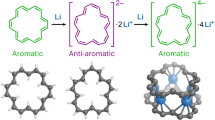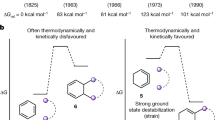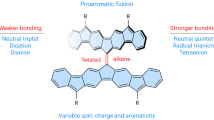Abstract
Oxatriquinanes are fused, tricyclic oxonium ions that are known to have exceptional stability compared to simple alkyl oxonium salts. C–O bonds in ethers are generally ∼1.43 Å in length, but oxatriquinane has been found to have C–O bond lengths of 1.54 Å. A search of the Cambridge Structural Database turned up no bona fide C–O bond length exceeding this value. Computational modelling of oxatriquinane alongside other alkyl oxonium ions indicated that the electronic consequences of molecular strain were primarily responsible for the observed bond elongation. We also show that substitution of the oxatriquinane ring system with alkyl groups of increasing steric demand pushes the C–O bond to unheard of distances, culminating in a tert-butyl derivative at a predicted 1.60 Å. Chemical synthesis and an X-ray crystallographic study of these compounds validated the results of the modelling work and, finally, an extraordinary 1.622 Å C–O bond was observed in 1,4,7-tri-tert-butyloxatriquinane.
This is a preview of subscription content, access via your institution
Access options
Subscribe to this journal
Receive 12 print issues and online access
$259.00 per year
only $21.58 per issue
Buy this article
- Purchase on Springer Link
- Instant access to full article PDF
Prices may be subject to local taxes which are calculated during checkout




Similar content being viewed by others
References
Møller, C. & Plesset, M. S. Note on an approximation treatment for many-electron systems. Phys. Rev. 46, 618–622 (1934).
Ditchfield, R., Hehre, W. J. & Pople, J. A. Self-consistent molecular-orbital methods. IX. An extended Gaussian-type basis for molecular-orbital studies of organic molecules. J. Chem. Phys. 54, 724–728 (1971).
Hehre, W. J., Ditchfield, R. & Pople, J. A. Self-consistent molecular orbital methods. XII. Further extensions of Gaussian-type basis sets for use in molecular orbital studies of organic molecules. J. Chem. Phys. 56, 2257–2261 (1972).
Hariharan, P. C. & Pople, J. A. The influence of polarization functions on molecular orbital hydrogenation energies. Theor. Chim. Acta 28, 213–222 (1973).
Weinhold, F. & Landis, C. R. Valency and Bonding: A Natural Bond Orbital Donor–Acceptor Perspective (Cambridge Univ. Press, 2005).
Hoffmann, R. & Hopf, H. Learning from molecules in distress. Angew. Chem. Int. Ed. 47, 4474–4481 (2008).
Allen, F. H. et al. Tables of bond lengths determined by X-ray and neutron-diffraction.1. Bond lengths in organic compounds. J. Chem. Soc. Perkin Trans. 2, S1–S19 (1987).
Kaupp, G. & Boy, J. Overlong C–C single bonds. Angew. Chem. Int. Ed. Engl. 36, 48–49 (1997).
Chandrasekhar, J. Organic structures with remarkable carbon carbon distances. Curr. Sci. 63, 114–116 (1992).
Dahl, J. E., Liu, S. G. & Carlson, R. M. K. Isolation and structure of higher diamondoids, nanometer-sized diamond molecules. Science 299, 96–99 (2002).
Fokin, A. A. et al. Stable alkanes containing very long carbon−carbon bonds. J. Am. Chem. Soc. 134, 13641–13650 (2012).
Oliva, J. M., Allan, N. L., Schleyer, P. V., Vinas, C. & Teixidor, F. Strikingly long C···C distances in 1,2-disubstituted ortho-carboranes and their dianions. J. Am. Chem. Soc. 127, 13538–13547 (2005).
Mascal, M., Hafezi, N., Meher, N. K. & Fettinger, J. C. Oxatriquinane and oxatriquinacene: extraordinary oxonium ions. J. Am. Chem. Soc. 130, 13532–13533 (2008).
Bruno, I. J. et al. New software for searching the Cambridge Structural Database and visualising crystal structures. Acta Crystallogr. B58, 389–397 (2002).
Spiridonov, V. P., Vogt, N. & Vogt, J. Determination of molecular structure in terms of potential energy functions from gas-phase electron diffraction supplemented by other experimental and computational data. Struct. Chem. 12, 349–376 (2001).
Schreiner, P. R. et al. Overcoming lability of extremely long alkane carbon–carbon bonds through dispersion forces. Nature 477, 308–311 (2011).
Jones, P. G. Crystal structure determination: a critical view. Chem Soc. Rev. 13, 157–172 (1984).
Childs, R. F., Kostyk, M. D., Lock, C. J. L. & Mahendran, M. Structural studies on 6-ethoxytetrahydropyrylium cations; stereoelectronic control in the reactions of lactonium salts. Can. J. Chem. 69, 2024–2032 (1991).
Childs, R. F. et al. Structure, energetics and homoaromaticity. Pure Appl. Chem. 58, 111–128 (1986).
Lork, E., Görtler, B., Knapp, C. & Mews, R. Alkylation of OPF3 by MeOSO+AsF6−: the unexpected formation of a dioxadiarsetane. Solid State Sci. 4, 1403–1411 (2002).
Etzkorn, M. et al. 1-Oxoniaadamantane. Eur. J. Org. Chem. 4555–4558 (2008).
Akkerman, K., Beckmann, J. & Duthie, A. 1,1′-(1,4-Butanediyl)bis(tetrahydrofuranium) trifluoromethanesulfonate. Acta Crystallogr. E62, o2781–o2782 (2006).
Ishida, H. Protonation effect on C–N bond length of alkylamines studied by molecular orbital calculations. Z. Naturforsch. 55a, 769–771 (2000).
Reed, A. E., Curtiss, L. A. & Weinhold, F. Intermolecular interactions from a natural bond orbital, donor–acceptor viewpoint. Chem. Rev. 88, 899–926 (1988).
Bader, R. F. W. Atoms in molecules. Acc. Chem. Res. 18, 9–15 (1985).
Bader, R. F. W. A quantum theory of molecular structure and its applications. Chem. Rev. 91, 893–928 (1991).
Wiberg, K. B. Concept of strain in organic chemistry. Angew. Chem. Int. Ed. Engl. 25, 312–322 (1986).
Engler, E. M., Andose, J. D. & von Schleyer, P. R. Critical evaluation of molecular mechanics. J. Am. Chem. Soc. 95, 8005–8025 (1973).
Cremer, D. & Kraka, E. Theoretical determination of molecular structure and conformation. 15. Three-membered rings: bent bonds, ring strain, and surface delocalization. J. Am. Chem. Soc. 107, 3800–3810 (1985).
Wiberg, K. A. Application of the Pople–Santry–Segal CNDO method to the cyclopropylcarbinyl and cyclobutyl cation and to bicyclobutane. Tetrahedron 24, 1083–1096 (1966).
Cioslowski, J. & Mixon, S. T. Topological properties of electron density in search of steric interactions in molecules: electronic structure calculations on ortho-substituted biphenyls. J. Am. Chem. Soc. 114, 4382–4387 (1992).
Stoyanov, E. S. et al. The R3O+···H+ hydrogen bond: toward a tetracoordinate oxadionium(2+) ion. J. Am. Chem. Soc. 134, 707–714 (2012).
Mascal, M., Hafezi, N. & Toney, M. D. 1,4,7-Trimethyloxatriquinane: SN2 reaction at tertiary carbon. J. Am. Chem. Soc. 132, 10662–10664 (2010).
Acknowledgements
This work was supported financially by the National Science Foundation (grants CHE-0957798 to M.M. and CHE-1058483 to M.P.M.). G.G. thanks the Turkish Higher Education Council for a studentship.
Author information
Authors and Affiliations
Contributions
G.G. performed synthetic, computational and crystallographic work. N.H. and W.L.S. performed synthetic work. M.M.O. provided assistance with crystallographic work. I.V.S. obtained crystals of 16. F.S.T. performed the crystallographic work on 16. M.P.M. performed computational work and interpreted computational results. M.M. supervised the project, composed the manuscript, and performed database and computational work.
Corresponding author
Ethics declarations
Competing interests
The authors declare no competing financial interests.
Supplementary information
Supplementary information
Supplementary information (PDF 2721 kb)
Supplementary information
Crystallographic data for compound 13 (CIF 29 kb)
Supplementary information
Crystallographic data for compound 14 (CIF 16 kb)
Supplementary information
Crystallographic data for compound 15 (CIF 11 kb)
Supplementary information
Crystallographic data for compound 16 (CIF 51 kb)
Rights and permissions
About this article
Cite this article
Gunbas, G., Hafezi, N., Sheppard, W. et al. Extreme oxatriquinanes and a record C–O bond length. Nature Chem 4, 1018–1023 (2012). https://doi.org/10.1038/nchem.1502
Received:
Accepted:
Published:
Issue Date:
DOI: https://doi.org/10.1038/nchem.1502




